In 2017, longtime Harvard Forest director and Vineyard summer resident David Foster made a prediction about the forests of Martha’s Vineyard: the arboreal future of the Island would lie with the beech tree, he said. After three centuries of extensive land use, the Island’s forests had been slowly recovering to a state mostly unseen since European arrival.
“The only thing that could have altered that is a disease which systemically affects the species,” Foster explained recently of his prediction, noting that the beech population has been steadily increasing since the 1950s. And then came the worms.
Litylenchus crenatae subspecies mccannii, a microscopic nematode, was first identified on the Vineyard in 2022. It’s a little worm with a big appetite, devourer of beech trees, menace to forests and gardens alike. All over the Island this past summer, if you examined the leaves of beeches native and ornamental, you may well have noticed the first unassuming sign of these creatures: the necrotic leaf striping that indicates a case of Beech Leaf Disease (BLD). As the condition progresses, the leaves blacken and wither, and next spring’s buds leaf out early, perhaps several times in a season. After a few years of this start-again, stop-again, the tree gets tired, worn out. It is often a terminal prognosis.
The disease was first identified on trees in Ohio in 2012, but it took several years for scientists to peg the nematode as its cause. “Nematode pathologies are more and more common these days,” said Karen L. Snover-Clift, director of the Cornell Plant Disease Diagnostic Clinic. “I think they might be out there a little more than we know about, but we just don’t recognize it.”
Nematodes are often overlooked, echoed Tim Boland, executive director of the Polly Hill Arboretum in West Tisbury, but not because they are rare. “They are one of the most ubiquitous multi-cell organisms on the planet,” he said, “but because we can’t see them, we don’t think about them.”
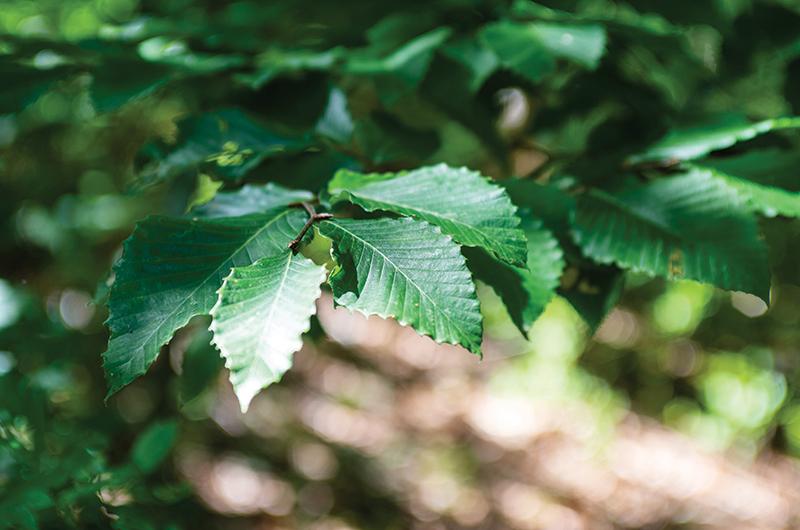
Once beeches at the arboretum became infected, however, visibility ceased to be a conceptual barrier. “When the sun shines through, it is really quite noticeable,” Boland said, looking up into the ominously purple-striped leaves of a Fagus sylvatica “Rohanii” European beech, the first specimen there to show obvious signs of infection. Since that diagnosis, ten out of their twenty-five specimen beeches have shown signs of infection, plus hundreds of native beeches in their forty-acre managed native forest. On a stroll through the property, Boland stopped to examine each beech for striping and added several new trees to his informal mental survey of patients.
The tell-tale striping, Boland said, is the result of nematodes feasting on sugary mesophyll (“the meat of the leaf”). This gluttonous revelry compromises the trees’ ability to photosynthesize. Thus, as the nematodes feast, the tree begins to starve. “It’s their sheer presence. There’s no bacteria or virus associated with the nematode; it’s just the volume of their physical presence and their eating,” he said. “It punches them in the gut.”
Three years of infection is enough to kill trees, young saplings being the most at risk. The progression is fast and deadly, an indication to tree experts that something is wrong ecologically.
“It’s not very smart to kill your host; that’s not a good longevity strategy,” said Ian Jochems, Polly Hill’s ground manager and arborist. “So that’s when you know that it’s a foreign pest on a native species.” Just as the medieval bubonic plague became more virulent and deadly when it made the jump from rats to humans, Litylenchus crenatae may have intensified after jumping between beech species.
The pathway that L. crenatae took to get to the native and ornamental beeches of North America is debated among plant pathologists, but the leading theory goes something like this: an endemic parasitic, L. crenatae subspecies crenatae, was making its way through beeches in Japan. Somehow, possibly through the importation of ornamental trees or lumber, it arrived in the U.S., perhaps touching down somewhere in Ohio. The worm made the jump to native American and ornamental European beeches, and sub-speciated into L. crenatae mccannii.
Researchers have also developed a theory to explain its rapid spread. In the springtime, purple finches love to eat fresh beech buds, Boland explained, some of which now contain scores of nematode eggs. As the birds flutter from tree to tree, they pick up and drop off mites, tiny eight-legged arachnids that are generally harmless to the trees themselves, but which have been shown in a laboratory to be nematode carriers.
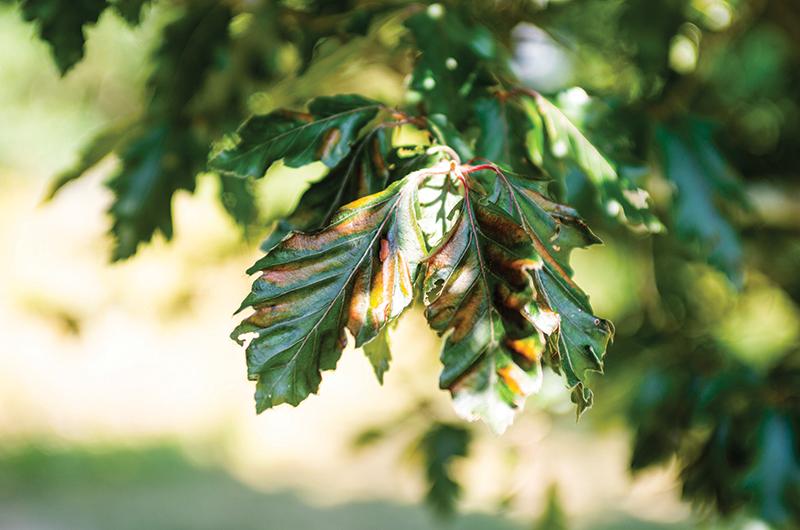
Regardless of what brought the nematodes, they have definitely arrived on the Island, to the dismay of that rarified group of arboreal professionals that the Europeans term “tree surgeons” and Americans, somewhat less imaginatively, call arborists.
“The beech is such a great tree, such a rock star solid tree,” said Jochems, who manages his own arborist business, Jochems Tree Care & Consulting, alongside his work with Polly Hill. “It’s really a shame.”
For Jochems and other local arborists, the threat of a mass die-off is not mere abstraction. The cynipid wasp plague of the 2010s still casts a long shadow. Rather than eating the leaves, cynipids laid their eggs in oak twigs, forming galls (globular growths) that blocked off the trees’ vascular systems. Thousands of Island oaks perished, but for those that survived long enough, nature eventually came through to settle the score.
“We had two or three years where it got really bad, and in the cycle, eventually we started to see a slow buildup of the predators for the wasp,” said Jochems. “The question that’s going to come with this one is, ‘What’s the predator?’…Hopefully, something will come around to even the playing field a little bit, without it having to be done completely chemically.”
So far, no predator has emerged to devour the microscopic worms, nor has any foolproof treatment for the disease been identified. “There’s no magic bullet,” said Jochems. “It’s just health and luck at this point.” Luck is beyond the control of the arborists, but tree health is well within their grasp.
In a release this past June, the local franchise of Bartlett Tree Experts, a tree care company that also has a national research laboratory, suggested Islanders might give their beeches a better chance at battling BLD by addressing their soil health. Jochems, who works closely with Bartlett’s Island arborist Mark DiBiase, has thus far focused on mycorrhizal promoters, boosting the beneficial soil microbiome, while avoiding tree fertilizers that might inadvertently encourage the pests.
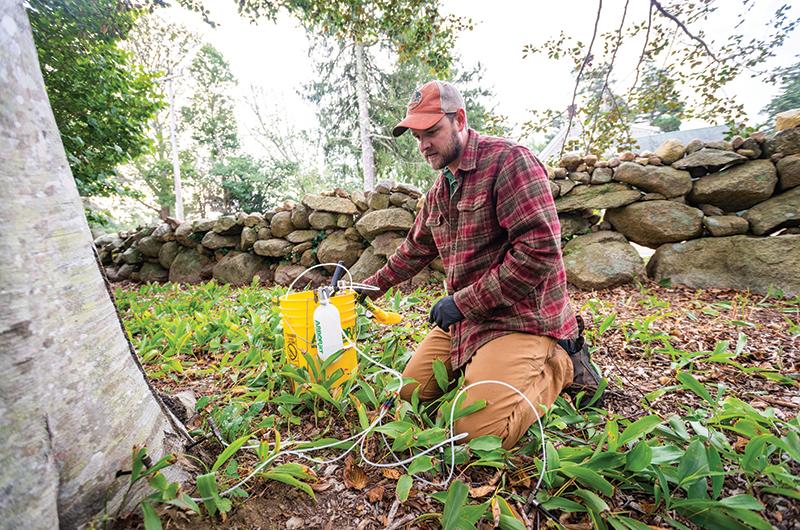
He has also begun an experimental course of the chemical Emamectin Benzoate for the affected trees at the arboretum, administered by the arboreal equivalent of intravenous injection. “We inject it at the base of the tree, and systematically it will translocate up through the tree through the canopy into the leaves,” he said. “It’s supposed to kill what’s in the leaves and make it so the nematode cannot produce an egg.”
Realistically, though, Jochems has resigned himself to the reality that a good number of the beeches at the arboretum won’t survive. “It is a bummer if we lose big trees, but it’s part of the research and part of learning,” he said.
As they did when they began combating the cynipids, Jochems is in the process of going through the collection and rating each tree’s severity of infection. In two years, when the course of the medicine is complete, they will know which trees are worth saving and which are beyond salvage. “We have to look at it as an opportunity to learn about how we can help the rest of the Island,” he said.
Because the disease was first spotted in Ohio a decade ago, arborists in the Northeast have been able to benefit from research already in progress. Hartney Greymont, a large firm based in Boston, for instance, is using a polyphosphate soil drench to treat trees on the Cape and Islands in a new pilot program that extends a study begun by the city of Cleveland’s Metroparks system in 2016. “The treatment has shown promise on younger trees,” said Hartney Greymont arborist Natascha Batchelor, “now we are trying it out on the big ones.”
It’s still early in the fight. “Right now, we only have experimental treatments,” Jochems emphasized, “so right now it’s a little harder for homeowners. They need to be aware that this isn’t a guarantee, that you may spend money on treatment and your tree may still die.”
No matter how many trees die, each one still feels like a tragedy, especially those trees that have led a long and storied life. At Polly Hill, that tree is the Zladia beech, one of the first four trees (all beeches) planted by the arboretum’s eponymous founder in 1964. It is a vivid chartreuse specimen deep in the throes of severe BLD.
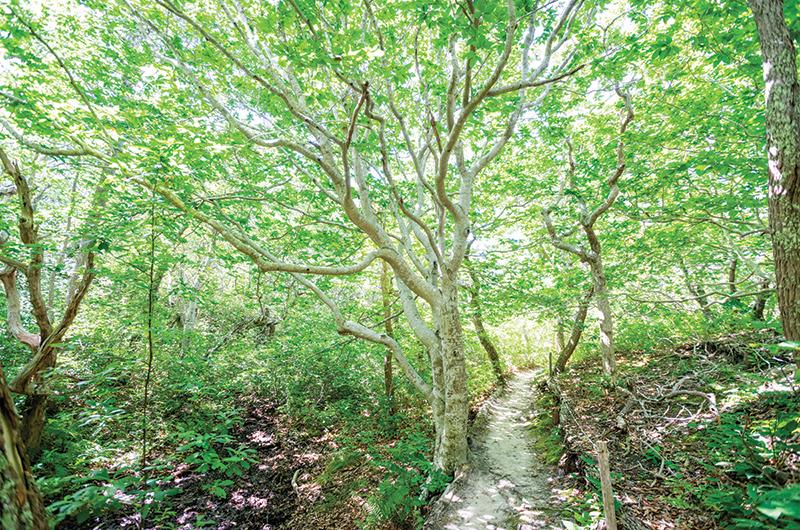
“It felt like a sucker punch,” said Boland of the day he found out that the tree was infected. Boland’s children grew up in the house that sits beside that tree, and he looked out his window to see it every day. “It really feels like a death in the family,” he said, looking up among foliage uncharacteristically thin and yellow. “But from a larger perspective, I worry about our natural forests; that’s going to determine whether we have a wholesale collapse of the species, like the American chestnut, or if we are going to be able to find resistance.”
The fate of the American chestnut looms darkly over the future of the beech as the absolute worst-case scenario. The chestnut was the most prominent tree in eastern American forests right up until the twentieth century when, just like the beech today, it fell victim to a pathogenic parasite imported from Asia. After fifty years, the American chestnut was functionally extinct, rarely growing past shrub stage in the wild.
Driving into Cedar Tree Neck Sanctuary in West Tisbury, you would never know that the beech tree potentially faces such peril. The long, winding dirt road into the property trailhead is encompassed in richly shading, full foliaged beeches without any hint of illness. Kristen Geagan, director of stewardship with the Sheriff’s Meadow Foundation, said she has only located a couple of ill trees in a single grove: “It’s not pervasive here yet, but I assume it will be.”
Cedar Tree Neck is what is known as a mesic, maritime forest, which is to say a wet forest close to the ocean. Its ecology starkly contrasts with the state forest, due to its geology – the maritime forests are largely formed of more substantial moraine, pushed into place by glaciers at their most recent maximum some eighteen thousand years ago, while the interior forests grew on the sandier outwash from that moraine.
“The beech was a long time andvery large component of Vineyard land,” said Foster, who is the author of A Meeting of Land and Sea: Nature and the Future of Martha’s Vineyard (Yale University Press, 2017). He said that even members of Bartholomew Gosnold’s 1602 voyage to the region noted the prominence of the trees in the forest. But because the moraine where beeches grew was more fertile than the outwash, he explained, they were commonly cleared for pasture and cultivation (as was the case for Cedar Tree Neck, major portions of which were dedicated to the cows, sheep, potatoes, and turnips of the Daggett family).
The fields remained open, and the beeches cut, for the first 250 years of European occupation, up until the 1890s, when intensive land use on the Island started to cool off and fields were slowly allowed to rewild. It was a long journey to where we are now: in the 1960s, ecologist and Island-native James Gordon “Pete” Ogden III described Island forests as “somewhat bedraggled in a vegetational sense.”
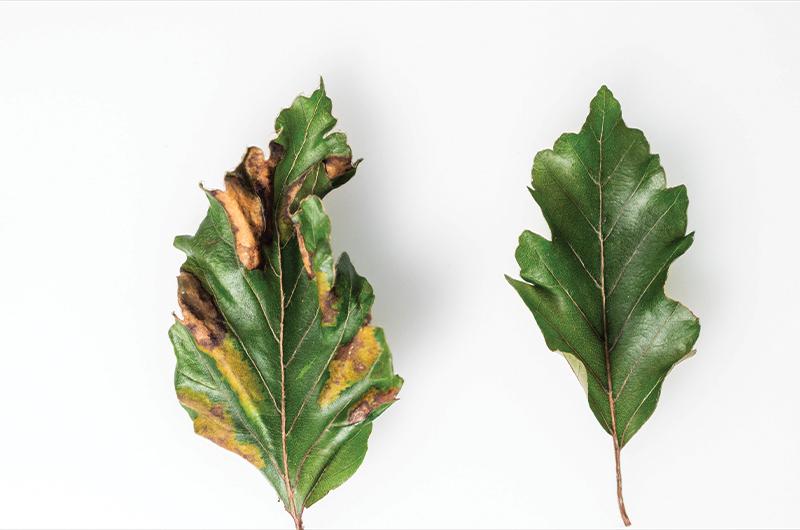
Writing for The American Midland Naturalist, Ogden was uniquely poised to witness the real-time reforestation of Island pastures. First, he noted, came the junipers, then the pines, then the oaks, and then, in areas that had enough moisture, came the beeches. They are pickier about their conditions, and slower, more deliberate growers, but they completely change the character of a forest – their reappearance marks a return to the lush, towering forests that Gosnold described.
Beeches are a favorite of strollers through the forest, and their tenacious ability to capture sunlight precludes most other vegetation from growing. “Their leaves don’t fall off until their buds emerge in the spring,” said Geagan, among the same beeches beneath whose foliage she was married. “They stay on as golden leaves to block off the light at the forest floor.”
As a result there is an eerie, fey quality to the bare, well-shaded ground beneath mature beech groves. Beechdrops, a parasitic, non-photosynthetic plant that feeds off beech roots, are among the only plants that grow, otherworldly pale-purple flowers on a brown-beige stem. Unlike L. crenatae, the beechdrop is a properly ecological parasite, taking its cut of the beech’s food without jeopardizing the health of its host. The nematode risks the existence of the tree as well as its tree-parasitic brothers in arms.
Cedar Tree Neck is only showing the most preliminary signs of a BLD infection, just a couple symptomatic trees on the entire 400 acre property. But it already has Geagan thinking far into the future.
“I don’t think we’ll really know until five years out what’s going to happen,” she said. “Initially, I am worried about a specific clump of trees, like this one, but then you have to think more generally about how it’s going to affect the forest across the whole property, and what kind of changes we are going to see. If we have a massive death of beech groves across this property, what’s going to come up in its place?”
The same wet conditions that make Cedar Tree Neck so amenable to beeches make the trees difficult to treat chemically without risking runoff into the sensitive wetlands. Even if that could be prevented, and even if there was a reliable, low-impact medicine, treating a whole forest of trees is simply infeasible. Not to mention all of the as yet unknown effects that the illness (or the treatment) might have.
“There is a huge tendency to act just to do something,” said Foster, “and my general response is that we are better off doing nothing until we know an awful lot more about it. Making the decision not to do something is a huge management decision, and an important one.” But that logic doesn’t make it any easier.
“If we lost these two, I think I would cry,” said Geagan, looking up at Cedar Tree Neck’s iconic squat and craggly beech couple located on the white trail.
Humans will miss their shade and beauty, squirrels their sweet nuts, birds the tender buds, which they nibbled to unknowingly spread BLD. Even the offending nematodes will miss the bounteous sugary beech mesophyll upon which they now feast.
The forests could live on without the beeches, though they would be less beautiful. But the beech has already survived one extermination on the Island – who is to say it will not survive another?
All we can do is hope, and watch out for stripes.

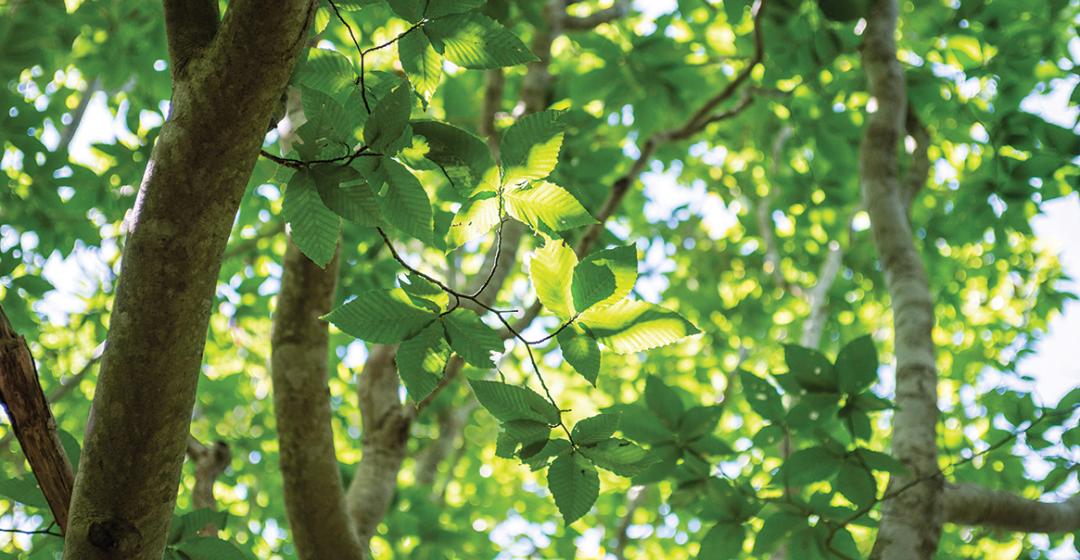


 1 comment
1 comment
Comments (1)